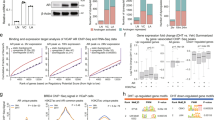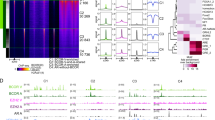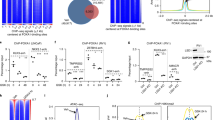Abstract
Nuclear expression of CCAAT enhancer binding protein-α (C/EBPα), which supports tissue differentiation through several antiproliferative protein–protein interactions, augurs terminal differentiation of prostate epithelial cells. C/EBPα is also a tumor suppressor, but in many tumors its antiproliferative interactions may be attenuated by de-phosphorylation. C/EBPα acts as a corepressor of the classical androgen response element (ARE)-mediated gene activation by the androgen receptor (AR), but this is paradoxical as the genotropic actions of AR are crucial not only for the growth of the prostate but also for its maintenance and function. We show that DNA-bound C/EPBα recruits AR to activate transcription. C/EBPα-dependent trans-activation by AR also overrode suppression of AREs by C/EBPα elsewhere in a promoter. This mechanism was remarkable in that its androgen dependence was apparently for nuclear translocation of AR; it was otherwise androgen independent, flutamide insensitive and tolerant to disruption of AR dimerization. Gene response profiles and global chromatin associations in situ supported the direct bimodal regulation of AR transcriptional signaling by C/EBPα. This unique mechanism explains the functional coordination between AR and C/EPBα in the prostate and also shows that hormone-refractory AR signaling in prostate cancer could occur through receptor tethering.
This is a preview of subscription content, access via your institution
Access options
Subscribe to this journal
Receive 50 print issues and online access
$259.00 per year
only $5.18 per issue
Buy this article
- Purchase on Springer Link
- Instant access to full article PDF
Prices may be subject to local taxes which are calculated during checkout








Similar content being viewed by others
References
Aarnisalo P, Palvimo JJ, Jänne OA . (1998). CREB-binding protein in androgen receptor-mediated signaling. Proc Natl Acad Sci 95: 2122–2127.
Baron S, Manin M, Beaudoin C, Leotoing L, Communal Y, Veyssiere G et al. (2004). Androgen receptor mediates non-genomic activation of phosphatidylinositol 3-OH kinase in androgen-sensitive epithelial cells. J Biol Chem 279: 14579–14586.
Beato M, Herrlich P, Schutz G . (1995). Steroid hormone receptors: many actors in search of a plot. Cell 83: 851–857.
Berrevoets CA, Doesburg P, Steketee K, Trapman J, Brinkmann AO . (1998). Functional interactions of the AF-2 activation domain core region of the human androgen receptor with the amino-terminal domain and with the transcriptional coactivator TIF2 (transcriptional intermediary factor2). Mol Endocrinol 12: 1172–1183.
Bourguet W, Germain P, Gronemeyer H . (2000). Nuclear receptor ligand-binding domains: three-dimensional structures, molecular interactions and pharmacological implications. Trends Pharmacol Sci 21: 381–388.
Burel SA, Harakawa N, Zhou L, Pabst T, Tenen DG, Zhang DE . (2001). Dichotomy of AML1-ETO functions: growth arrest versus block of differentiation. Mol Cell Biol 21: 5577–5590.
Chattopadhyay S, Gong EY, Hwang M, Park E, Lee HJ, Hong CY et al. (2006). The CCAAT enhancer-binding protein-alpha negatively regulates the transactivation of androgen receptor in prostate cancer cells. Mol Endocrinol 20: 984–995.
Edwards J, Bartlett JM . (2005). The androgen receptor and signal-transduction pathways in hormone-refractory prostate cancer. Part 1: modifications to the androgen receptor. BJU Int 95: 1320–1326.
Ettwiller L, Paten B, Ramialison M, Birney E, Wittbrodt J . (2007). Trawler: de novo regulatory motif discovery pipeline for chromatin immunoprecipitation. Nat Methods 4: 563–565.
Frønsdal K, Engedal N, Slagsvold T, Saatcioglu F . (1998). CREB binding protein is a coactivator for the androgen receptor and mediates cross-talk with AP-1. J Biol Chem 273: 31853–31859.
Gelmann EP . (2002). Molecular biology of the androgen receptor. J Clin Oncol 20: 3001–3015.
Gery S, Tanosaki S, Bose S, Bose N, Vadgama J, Koeffler HP . (2005). Down-regulation and growth inhibitory role of C/EBPalpha in breast cancer. Clin Cancer Res 11: 3184–3190.
Glass CK, Rosenfeld MG . (2000). The coregulator exchange in transcriptional functions of nuclear receptors. Genes Dev 14: 121–141.
Halmos B, Huettner CS, Kocher O, Ferenczi K, Karp DD, Tenen DG . (2002). Down-regulation and antiproliferative role of C/EBPalpha in lung cancer. Cancer Res 62: 528–534.
Han S, Roman J . (2007). Peroxisome proliferator-activated receptor gamma: a novel target for cancer theraputics? Anticancer Drugs 18: 237–244.
Harris TE, Albrecht JH, Nakanishi M, Darlington GJ . (2001). CCAAT/enhancer-binding protein-alpha cooperates with p21 to inhibit cyclin-dependent kinase-2 activity and induces growth arrest independent of DNA binding. J Biol Chem 276: 29200–29209.
Hendricks-Taylor LR, Darlington GJ . (1995). Inhibition of cell proliferation by C/EBP alpha occurs in many cell types, does not require the presence of p53 or Rb, and is not affected by large T-antigen. Nucleic Acids Res 23: 4726–4733.
Hong H, Kohli K, Trivedi A, Johnson DL, Stallcup MR . (1996). GRIP1, a novel mouse protein that serves as a transcriptional coactivator in yeast for the hormone binding domains of steroid receptors. Proc Natl Acad Sci USA 93: 4948–4952.
Jakacka M, Ito M, Weiss J, Chien PY, Gehm BD, Jameson JL . (2001). Estrogen receptor binding to DNA is not required for its activity through the nonclassical AP1 pathway. J Biol Chem 276: 13615–13621.
Jenster G, Trapman J, Brinkmann AO . (1993). Nuclear import of the human androgen receptor. Biochem J 293 (Pt 3): 761–768.
Jenster G, van der Korput HA, Trapman J, Brinkmann AO . (1995). Identification of two transcription activation units in the N-terminal domain of the human androgen receptor. J Biol Chem 270: 7341–7346.
Jia L, Coetzee GA . (2005). Androgen receptor-dependent PSA expression in androgen-independent prostate cancer cells does not involve androgen receptor occupancy of the PSA locus. Cancer Res 65: 8003–8008.
Kousteni S, Bellido T, Plotkin LI, O’Brien CA, Bodenner DL, Han L et al. (2001). Nongenotropic, sex-nonspecific signaling through the estrogen or androgen receptors: dissociation from transcriptional activity. Cell 104: 719–730.
Loomis KD, Zhu S, Yoon K, Johnson PF, Smart RC . (2007). Genetic ablation of CCAAT/enhancer binding protein alpha in epidermis reveals its role in suppression of epithelial tumorigenesis. Cancer Res 67: 6768–6776.
Manolagas SC, Kousteni S . (2001). Perspective: nonreproductive sites of action of reproductive hormones. Endocrinology 142: 2200–2204.
McEwan IJ . (2004). Molecular mechanisms of androgen receptor-mediated gene regulation: structure-function analysis of the AF-1 domain. Endocr Relat Cancer 11: 281–293.
McKenna NJ, O’Malley BW . (2002). Combinatorial control of gene expression by nuclear receptors and coregulators. Cell 108: 465–474.
Miyamoto H, Messing EM, Chang C . (2004). Androgen deprivation therapy for prostate cancer: current status and future prospects. Prostate 61: 332–353.
Muller C, Calkhoven CF, Sha X, Leutz A . (2004). The CCAAT enhancer-binding protein alpha (C/EBPalpha) requires a SWI/SNF complex for proliferation arrest. J Biol Chem 279: 7353–7358.
Nerlov C, Ziff EB . (1994). Three levels of functional interaction determine the activity of CCAAT/enhancer binding protein-alpha on the serum albumin promoter. Genes Dev 8: 350–362.
Osada S, Yamamoto H, Nishihara T, Imagawa M . (1996). DNA binding specificity of the CCAAT/enhancer-binding protein transcription factor family. J Biol Chem 271: 3891–3896.
Pabst T, Mueller BU, Harakawa N, Schoch C, Haferlach T, Behre G et al. (2001a). AML1-ETO downregulates the granulocytic differentiation factor C/EBPalpha in t(8;21) myeloid leukemia. Nat Med 7: 444–451.
Pabst T, Mueller BU, Zhang P, Radomska HS, Narravula S, Schnittger S et al. (2001b). Dominant-negative mutations of CEBPA, encoding CCAAT/enhancer binding protein-alpha (C/EBPalpha), in acute myeloid leukemia. Nat Genet 27: 263–270.
Paltoo D, Woodson K, Taylor P, Albanes D, Virtamo J, Tangerea J . (2003). Pro12Ala polymorphism in the peroxisome proliferator-activated receptor-gamma (PPAR-gamma) gene and risk of prostate cancer among men in a large cancer prevention study. Cancer Lett 191: 67–74.
Porse BT, Pedersen TA, Xu X, Lindberg B, Wewer UM, Friis-Hansen L et al. (2001). E2F repression by C/EBPalpha is required for adipogenesis and granulopoiesis in vivo. Cell 107: 247–258.
Pratt WB, Toft DO . (1997). Steroid receptor interactions with heat shock protein and immunophilin chaperones. Endocr Rev 18: 306–360.
Quigley CA, De Bellis A, Marschke KB, el-Awady MK, Wilson EM, French FS . (1995). Androgen receptor defects: historical, clinical, and molecular perspectives. Endocr Rev 16: 271–321.
Ramji DP, Foka P . (2002). CCAAT/enhancer-binding proteins: structure, function and regulation. Biochem J 365: 561–575.
Roy AK, Lavrovsky Y, Song CS, Chen S, Jung MH, Velu NK et al. (1999). Regulation of androgen action. Vitam Horm 55: 309–352.
Ruizeveld de Winter JA, Janssen PJ, Sleddens HM, Verleun-Mooijman MC, Trapman J, Brinkmann AO et al. (1994). Androgen receptor status in localized and locally progressive hormone refractory human prostate cancer. Am J Pathol 144: 735–746.
Sadowski I, Ptashne M . (1989). A vector for expressing GAL4(1-147) fusions in mammalian cells. Nucleic Acids Res 17: 7539.
Safe S, Kim K . (2004). Nuclear receptor-mediated transactivation through interaction with Sp proteins. Prog Nucleic Acid Res Mol Biol 77: 1–36.
Schoenmakers E, Verrijdt G, Peeters B, Verhoeven G, Rombauts W, Claessens F . (2000). Differences in DNA binding characteristics of the androgen and glucocorticoid receptors can determine hormone-specific responses. J Biol Chem 275: 12290–12297.
Schuster MB, Porse BT . (2006). C/EBPalpha: a tumour suppressor in multiple tissues? Biochim Biophys Acta 1766: 88–103.
Shaffer PL, Jivan A, Dollins DE, Claessens F, Gewirth DT . (2004). Structural basis of androgen receptor binding to selective androgen response elements. Proc Natl Acad Sci USA 101: 4758–4763.
Shand RL, Gelmann EP . (2006). Molecular biology of prostate-cancer pathogenesis. Curr Opin Urol 16: 123–131.
Shatnawi A, Tran T, Ratnam M . (2007). R5020 and RU486 act as progesterone receptor agonists to enhance Sp1/Sp4-dependent gene transcription by an indirect mechanism. Mol Endocrinol 21: 635–650.
Sun M, Yang L, Feldman RI, Sun XM, Bhalla KN, Jove R et al. (2003). Activation of phosphatidylinositol 3-kinase/Akt pathway by androgen through interaction of p85alpha, androgen receptor, and Src. J Biol Chem 278: 42992–43000.
Sundfeldt K, Ivarsson K, Carlsson M, Enerback S, Janson PO, Brannstrom M et al. (1999). The expression of CCAAT/enhancer binding protein (C/EBP) in the human ovary in vivo: specific increase in C/EBPbeta during epithelial tumour progression. Br J Cancer 79: 1240–1248.
Thomson AA, Marker PC . (2006). Branching morphogenesis in the prostate gland and seminal vesicles. Differentiation 74: 382–392.
Timchenko NA, Harris TE, Wilde M, Bilyeu TA, Burgess-Beusse BL, Finegold MJ et al. (1997). CCAAT/enhancer binding protein alpha regulates p21 protein and hepatocyte proliferation in newborn mice. Mol Cell Biol 17: 7353–7361.
Timchenko NA, Wilde M, Darlington GJ . (1999a). C/EBPalpha regulates formation of S-phase-specific E2F-p107 complexes in livers of newborn mice. Mol Cell Biol 19: 2936–2945.
Timchenko NA, Wilde M, Iakova P, Albrecht JH, Darlington GJ . (1999b). E2F/p107 and E2F/p130 complexes are regulated by C/EBPalpha in 3T3-L1 adipocytes. Nucleic Acids Res 27: 3621–3630.
Timchenko NA, Wilde M, Nakanishi M, Smith JR, Darlington GJ . (1996). CCAAT/enhancer-binding protein alpha (C/EBP alpha) inhibits cell proliferation through the p21 (WAF-1/CIP-1/SDI-1) protein. Genes Dev 10: 804–815.
Tsai MJ, O’Malley BW . (1994). Molecular mechanisms of action of steroid/thyroid receptor superfamily members. Annu Rev Biochem 63: 451–486.
Umek RM, Friedman AD, McKnight SL . (1991). CCAAT-enhancer binding protein: a component of a differentiation switch. Science 251: 288–292.
Vlahopoulos S, Zimmer WE, Jenster G, Belaguli NS, Balk SP, Brinkmann AO et al. (2005). Recruitment of the androgen receptor via serum response factor facilitates expression of a myogenic gene. J Biol Chem 280: 7786–7792.
Wang GL, Iakova P, Wilde M, Awad S, Timchenko NA . (2004). Liver tumors escape negative control of proliferation via PI3K/Akt-mediated block of C/EBP alpha growth inhibitory activity. Genes Dev 18: 912–925.
Wang GL, Timchenko NA . (2005). Dephosphorylated C/EBPalpha accelerates cell proliferation through sequestering retinoblastoma protein. Mol Cell Biol 25: 1325–1338.
Wang H, Goode T, Iakova P, Albrecht JH, Timchenko NA . (2002). C/EBPalpha triggers proteasome-dependent degradation of cdk4 during growth arrest. EMBO J 21: 930–941.
Wang H, Iakova P, Wilde M, Welm A, Goode T, Roesler WJ et al. (2001). C/EBPalpha arrests cell proliferation through direct inhibition of Cdk2 and Cdk4. Mol Cell 8: 817–828.
Wang Q, Li W, Liu XS, Carroll JS, Janne OA, Keeton EK et al. (2007). A hierarchical network of transcription factors governs androgen receptor-dependent prostate cancer growth. Mol Cell 27: 380–392.
Watkins PJ, Condreay JP, Huber BE, Jacobs SJ, Adams DJ . (1996). Impaired proliferation and tumorigenicity induced by CCAAT/enhancer-binding protein. Cancer Res 56: 1063–1067.
Wettenhall JM, Simpson KM, Satterley K, Smyth GK . (2006). affylmGUI: a graphical user interface for linear modeling of single channel microarray data. Bioinformatics 22: 897–899.
Xu Y, Chen SY, Ross KN, Balk SP . (2006). Androgens induce prostate cancer cell proliferation through mammalian target of rapamycin activation and post-transcriptional increases in cyclin D proteins. Cancer Res 66: 7783–7792.
Yu YP, Landsittel D, Jing L, Nelson J, Ren B, Liu L et al. (2004). Gene expression alterations in prostate cancer predicting tumor aggression and preceding development of malignancy. J Clin Oncol 22: 2790–2799.
Zegarra-Moro OL, Schmidt LJ, Huang H, Tindall DJ . (2002). Disruption of androgen receptor function inhibits proliferation of androgen-refractory prostate cancer cells. Cancer Res 62: 1008–1013.
Zhang J, Wilkinson JE, Gonit M, Keck R, Selman S, Ratnam M . (2008). Expression and sub-cellular localization of the CCAAT/enhancer binding protein alpha in relation to postnatal development and malignancy of the prostate. Prostate 68: 1206–1214.
Acknowledgements
Supported by NIH R01 grants CA 103964 and CA 80183 to MR.
Author information
Authors and Affiliations
Corresponding author
Additional information
Supplementary Information accompanies the paper on the Oncogene website (http://www.nature.com/onc)
Rights and permissions
About this article
Cite this article
Zhang, J., Gonit, M., Salazar, M. et al. C/EBPα redirects androgen receptor signaling through a unique bimodal interaction. Oncogene 29, 723–738 (2010). https://doi.org/10.1038/onc.2009.373
Received:
Revised:
Accepted:
Published:
Issue Date:
DOI: https://doi.org/10.1038/onc.2009.373
Keywords
This article is cited by
-
Androgen-regulated stromal complement component 7 (C7) suppresses prostate cancer growth
Oncogene (2023)
-
The miR-96 and RARγ signaling axis governs androgen signaling and prostate cancer progression
Oncogene (2019)
-
A tumor suppressor role for C/EBPα in solid tumors: more than fat and blood
Oncogene (2017)
-
Retinoic acid-related orphan receptor alpha (RORA) variants are associated with autism spectrum disorder
Metabolic Brain Disease (2017)
-
CCAAT/Enhancer binding protein β controls androgen-deprivation-induced senescence in prostate cancer cells
Oncogene (2015)



